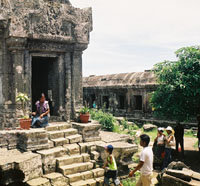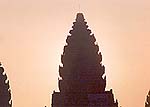


Section 3: Bhavalai - Another time
Around the Bhavalai and among the collapsed rubble of the towering lotus caped prang are the high arched corbelled vaulted galleries with their windows looking out onto the central sanctuary. The sun was casting a golden glow inside the gallery as well as creating a serpentine shadow on the gallery floor as it poured thru the open windows.
It was extremely quiet and I felt removed from everything else in the central sanctuary. The galleries were small enclosures which gave a sense of personal privacy and a true sense of sanctuary.
Here on top of the mountain was a sequestered gallery with no windows facing the vast Cambodian plains stretching southward but only shadowy walls surrounding the Bhavalai. It was here in these darkened hallways that devotion was nearest to the gods. The presence of the "Neak Ta" or "Nak Ta" (spirits) was very apparent. I walked back and forth inside the galleries for some time absorbing the density of the moist air and the ancient memories. I then climbed out of one of the windows and slowly made my way through the rubble of the fallen lotus tower prang and into the ante-chamber of the Bhavalai. A monk was quietly sitting awaiting those pilgrims who had come to give their respects to the Buddha. Lord Buddha was now being honored instead of Shiva but the Hindu temple was still a stark reminder of the former Devaraja ceremonies and rituals which once occupied this holy of holies.
 |
| 
It felt very natural to sit before the monk and bow politely. As I did water was sprinkled over me and in another one of those special moments I no longer felt I had a sense of who I was or where I was going but only a sense of being somewhere so totally removed from anywhere I had ever been before. Once again the infinite corners of the universe became the dominant space I found myself in similar to my experience at Angkor Wat in the central tower. What sounds were being chanted that could so utterly transform my attention? What words were being spoken to reach another part of my mind? Everything became suspended in time and my exploration through courtyards, rooms, and galleries led to this one spot of timelessness. Maybe it was a route that had already been planned out long before I decided to visit Preah Vihear. Maybe this was another initiation that I was finally able to experience because I wanted to learn more about what motivated and inspired the creation of this ancient Khmer civilization, and maybe it was the "Neak Ta" speaking to me. When I opened my eyes in the ante chamber it was fairly dark except for a small ray of light streaming through a torn veil with the image of the Buddha on it. The incense and floral odors were roaming around my nose and at some point I left my bowing posture, lifted my head, and wanted to say something but I couldn't find any words that felt appropriate. This must be the reasom I came to Praeh Vihear I thought; to be throughly entranced by the history and the mesmerizing chanting of a Cambodian monk.
Some how I found my way out of the central sanctuary and walked behind the southern face of the temple walls. I was quite unprepared for what happened next. While I was still in a most unusual state of mind from the monks chanting I came upon the cliffs edge overlooking the vast Cambodian jungles. If ever there could be a real sense of flying then this was the moment. I did not expect to see such a vast space open up before me. From being sequestered in the golden colored galleries, to paying my respects in the darkended holy chambers of the Bhavalai, the open space released my imagination to travel through the clouds and beyond. Over the canopy of the dark green forests Cambodian dust was filtering up through the trees in the distance. Hundreds of elephants were stomping on the dusty red soil making the air have a pink glow to it.

The faint sound of music could be heard coming from hundreds of muscians and dancers who were accompanying the King to pay respect to Lord Shiva on top of Preah Vihear. The palm-leaf books (sastras) were all safely packed away by the purohita (Vamasiva) and the hotar (Sikhasiva) indicating the sacred positions of the stars and the next great occasion for a new temple to be constructed or a new ritual to be performed for the gods. The Brahmin priests who accompanied the King also recorded the position of the equinoxes on the ecliptic called the "precession of the equinoxes", as well as the ecliptical constellations through which the sun passes and completes its full cycle through the twelve constellations every 26,000 years. The time was approaching for the next great alignment of the stars on the southern horizon, and the King was making his way to the top of the mountain with his followers and guides to wittness the constellation Draco and sing hymns of praise to all the stars in honor of Shiva. The mysteries enshrouded and protected within these sastra's concealled the most sacred knowledge of the universe and even the location of the center of the galaxy known to be the doorway to the other side of time.
The night sky was filled with meaning and the knowledge saved throughout pre-history from the ancient astrological texts was now going to be used for rituals and ceremonies on the sacred mountain of Preah Vihear. The axis of the world was about to be installed with the Shiva linga, and the journey to mythical Mt. Meru was about to be enacted. The churning of the great ocean of milk was the observance of the bright band of stars high above the heavens, and the celestial serpent was in command of everything that moved in the universe.
Vasuki, king of the Nagas, was watching from his sagittarian out post and preparing to support the great churning. King Yasovarman's royal linga was about to be set in the center of the central sanctuary which signified the cosmic axis and was an extention of the four corners of the universe. The temple would now have its personal quincunx or "four-cornered force field" and took the shape of an architectual mandala for cosmic alignment power and protection. The Devaraja was now in place and King Yasovarman was now a "Chakravartin" or lord of the world. Preah Vihear now became a sacred mountain and Yasovarman's soul was merged with the essence of Shiva's subtle being. The Shiva linga became the cosmic pillar symbolizing the sacred mountain Kailasa "the abode of the gods".
The purohita (Vamasiva) had his own special sastra containing the sacred calendar (Panchang) or the "five members" because of the calendars precise ability to locate the age of the moon each month, the constellation the moon was in, the day of the week, the eclipse, and the position of the planets. Vamasiva also paid respects to Shiva, the lord connecting earth with heaven, who could transform the mutable into the immutable. The connection of the stars with events on earth was the soul purview of the purohita. The King was always guided by the planets and constellations. The temples which were planned and eventually built were in effect star temples to stay in touch with the abode of the gods on Mt. Meru.
King Yasovarman was a Shaivite, a follower of Shiva, and the origins and cosmological significance of Shiva can not be underestimated for his influence on the succession of Khmer Kings for the next 300 years. It was Shiva who inspired and directed the King to harness the indigenious people of Cambodia to erect the great stairway to heaven on Preah Vihear.
All this heavenly devotion was translated into regal action which could be wittnessed as the King's procession passed through the jungles and began the ascent up the stairway of the sacred mountain. Now the procession of muscians became lounder and the sounds turned into a higher pitched shrill which pierced through my imaginary world. The sound at first was unfamiliar, but turned out to be an electronic toy chirping under an umbrella. It was not a royal parasol from my imaginary procession but an umbrella to a vendors cart placed beside the central sanctuary. The mood I had sustained for so long was broken and I had to turn and face a very different world of spiritual desolation.
It was at this cliffs edge that the reality of the encroaching commercialized world became sadly evident.
 Section 1: Piligrimage - Getting there
Section 1: Piligrimage - Getting there
 Section 2: Arrival - Photo Galleries
Section 2: Arrival - Photo Galleries
 Section 4: Antiquities - Capitalism and Spiritualism
Section 4: Antiquities - Capitalism and Spiritualism
 Section 5: Politics - Kings to Commoners
Section 5: Politics - Kings to Commoners
 "Preah Vihear: An Introdiction to the World Heritage Monument" by Sachchidanand Sahai
"Preah Vihear: An Introdiction to the World Heritage Monument" by Sachchidanand Sahai
Other stories related to the Khmer Empire.
 |
|  |
| 
Part I- Stones in the Sky - Before the Journey to Angkor Wat
Part II - Stones in the Sky - Journey to Angkor Wat - July 2002.
Part III - Stones in the Sky - Section I - Journey to Angkor Wat - March 2003.
Part III - Stones in the Sky - Section II - Journey to Angkor Wat - March 2003.
Part V - Stones in the Sky - Journey to Beng Mealea - October 2004.
Apsaras and Devatas - Photo documentation of female divinities at Angkor Wat.
Related links:
Heritage Watch - Dr. Doug O'Reilly, Director
History of Science, Vedic Studies, Astronomy - By Subhash Kak